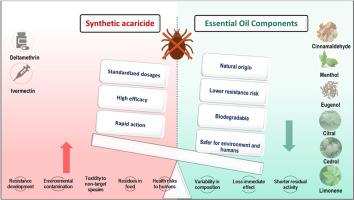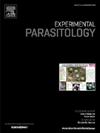Acaricidal activity of various essential oil components against acaricide-resistant Rhipicephalus microplus (Acari: Ixodidae)
IF 1.6
4区 医学
Q3 PARASITOLOGY
引用次数: 0
Abstract
Rhipicephalus microplus, an important ixodid tick species, poses significant economic and health challenges to the livestock directly by impairing animal productivity and serving as a vector for various pathogens. Although tick control strategies broadly integrate synthetic acaricides and environmental management, the emergence of acaricide resistance undermines these efforts thereby, necessitating alternative approaches. This study evaluated the acaricidal efficacy of six essential oil components (EOCs) such as cedrol, cinnamaldehyde, citral, eugenol, limonene and menthol against deltamethrin and ivermectin resistant R. microplus population by larval packet test. Among the studied EOCs, cinnamaldehyde exhibited the highest acaricide potential (LC50 = 0.042 %), followed by menthol (LC50 = 0.084 %), eugenol (LC50 = 0.171 %) and citral (LC50 = 0.185 %). Cedrol (LC50 = 1.09 %) demonstrated a lower activity, while limonene (LC50 = 22.0 %) was least effective. Probit regression analysis revealed steep dose-response slopes for cinnamaldehyde, citral and eugenol indicating strong acaricidal effects at low concentrations. These findings identify cinnamaldehyde, menthol, eugenol and citral as promising candidates for the development of plant-based acaricides, supporting their potential integration into the sustainable tick management strategies for management of acaricide-resistant R. microplus populations.

不同精油成分对抗螨小蜱(蜱螨科)的杀螨活性研究
微头蜱是一种重要的蜱类,它通过损害动物生产力和作为各种病原体的媒介,直接对牲畜造成重大的经济和健康挑战。尽管蜱虫控制策略广泛整合了合成杀螨剂和环境管理,但杀螨剂耐药性的出现破坏了这些努力,因此需要其他方法。本研究采用幼虫包试验的方法,评价了香柏醇、肉桂醛、柠檬醛、丁香酚、柠檬烯和薄荷醇6种精油成分对溴氰菊酯和伊维菌素耐药小夜蛾的杀螨效果。其中,肉桂醛的杀螨力最强(LC50 = 0.042%),其次是薄荷醇(LC50 = 0.084%)、丁香酚(LC50 = 0.171%)和柠檬醛(LC50 = 0.185%)。杉木醇(LC50 = 1.09%)的活性较低,柠檬烯(LC50 = 22.0%)的活性最低。概率回归分析显示,肉桂醛、柠檬醛和丁香酚在低浓度下具有较强的杀螨效果。这些发现确定肉桂醛、薄荷醇、丁香酚和柠檬醛是开发植物基杀螨剂的有希望的候选者,支持将它们整合到可持续的蜱虫管理策略中,以管理抗杀螨剂的小夜蛾种群。
本文章由计算机程序翻译,如有差异,请以英文原文为准。
求助全文
约1分钟内获得全文
求助全文
来源期刊

Experimental parasitology
医学-寄生虫学
CiteScore
3.10
自引率
4.80%
发文量
160
审稿时长
3 months
期刊介绍:
Experimental Parasitology emphasizes modern approaches to parasitology, including molecular biology and immunology. The journal features original research papers on the physiological, metabolic, immunologic, biochemical, nutritional, and chemotherapeutic aspects of parasites and host-parasite relationships.
 求助内容:
求助内容: 应助结果提醒方式:
应助结果提醒方式:


